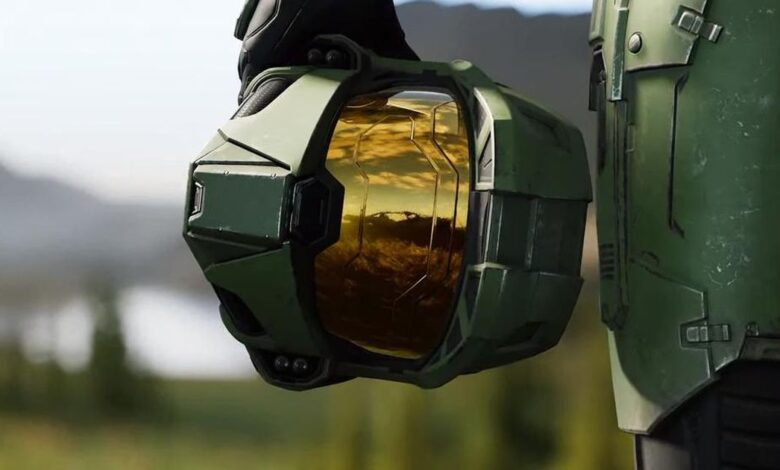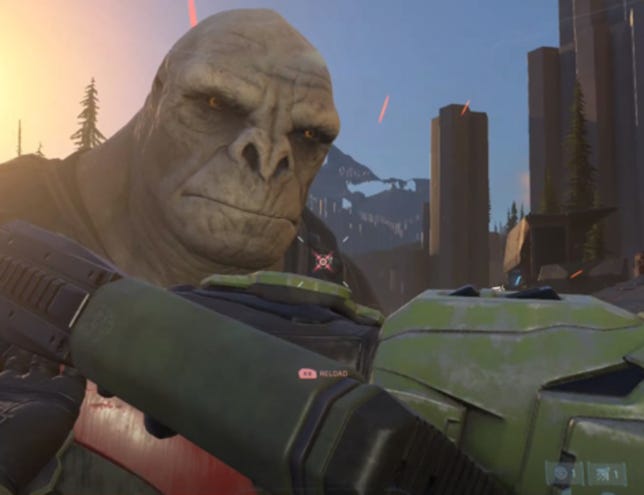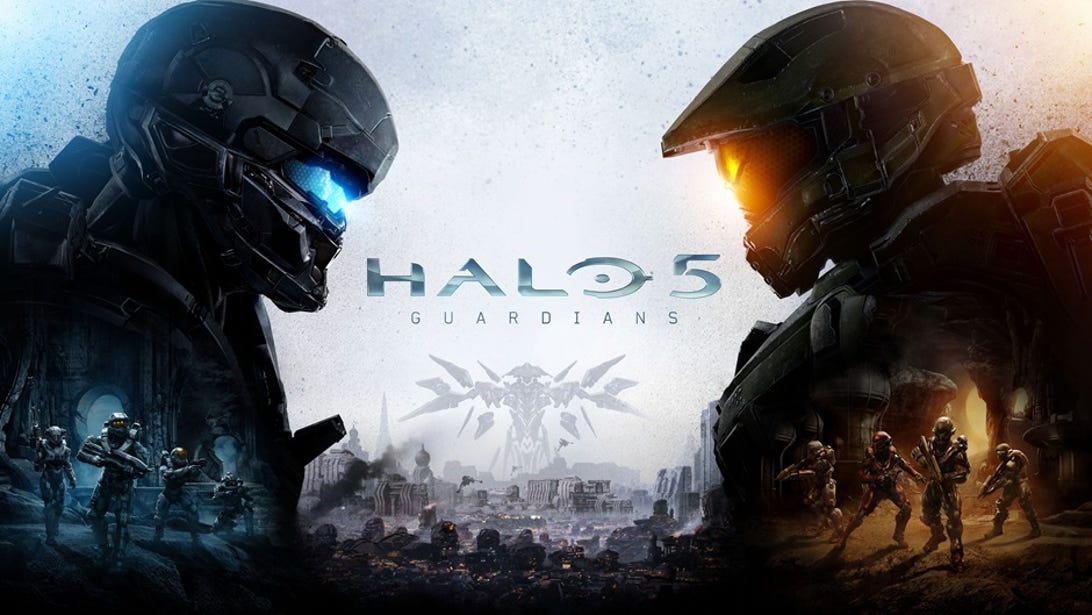Master Chief’s biggest test: Making Microsoft’s Halo Infinite worth playing

[ad_1]
Halo Infinite’s release, on Dec. 8, comes six years after the last installment in the series.
Microsoft/Screenshot by CNET
Microsoft wants Halo Infinite to be many things, and it will be tricky to balance them all. It’s the Halo team’s first attempt at a free-to-play online shooter. It also has a dramatic new multihour installment in the saga of its primary hero, Master Chief, told in an “open-world” setting where players can wander and explore rather than being sent from mission to mission.
But that all was in jeopardy with the Master Chief’s most hardcore fans a year and a half ago, when Microsoft showed off its first demonstration of Halo Infinite’s gameplay. At the time, the game was to helm the launch of Microsoft’s next big video game consoles, the $500 Xbox Series X and $300 Xbox Series S. Both devices focused on performance as their selling point, promising more intricately designed and better-looking games.
The fan outcry over the demo, which Microsoft had titled Ascension, convinced the company to delay the game another year to avert tarnishing one of the industry’s most storied video game franchises. That year ends on Wednesday, when Halo Infinite’s new story will go on sale for $60 for the Xbox and PC and will be made available for free for subscribers to the Xbox Game Pass. (The multiplayer online component of the game was made available as a beta on Nov. 15.)
Master Chief’s latest saga has him fighting aliens and saving humanity.
Microsoft
Bonnie Ross, a Microsoft corporate vice president and head of Halo maker 343 Industries, said the challenge her team faced was that of overambition. Microsoft wanted to offer Halo Infinite on Xbox and PC at the same time, another first, requiring additional engineering to make it work well with different types of computers and with Valve’s Steam online store, in addition to Microsoft’s own Xbox service.
In an interview shortly before the game’s launch, Ross discussed Halo Infinite’s development, which has been difficult not just because of the COVID-19 pandemic. All its firsts, she said, amounted to a lot of demands on the team. And that’s on top of the struggle any installment in a beloved longtime franchise faces: making a game that’s approachable for newcomers while satisfying for fans.
“It should feel familiar and comfortable if you’re a Halo player, and you should be able to see things other can’t because of the lore, but it should also be a place where a new person can come in and have a story,” she said. “This is our time to make sure we are paying homage to what is Halo.”
It’s been two decades since Master Chief, the primary hero of the Halo universe, blasted onto our screens. And to say it blasted is an understatement. As the launch title for Microsoft’s then-new Xbox video game console, Halo was front and center, quickly becoming a cultural phenomenon.
More than 81 million copies of Halo games have been sold so far. But it’s so much larger than that. Halo has spawned toys, cartoons, live-action adaptations, an esports league, more than 30 novels and about a dozen games. There’s a Halo version of Hasbro’s board game Risk and even an official gold-plated necklace shaped like one of the game’s most popular alien weapons, the energy sword.
Ross has been at Microsoft for more than three decades, earlier working on titles like the Zoo Tycoon simulation game and the action adventure Crackdown. She took over Halo in 2007, when the original developer, Bungie, split off from Microsoft in order to make the online shooting game Destiny.

Bonnie Ross, corporate vice president and head of 343 Industries at Microsoft.
Microsoft
Halo Infinite’s development was different from previous installments in part because it was being built on new coding technology, called the SlipStream game engine, which was designed to help Halo’s developers create the expansive space-age world where Master Chief fights foes to save humanity.
Ross said SlipStream wasn’t ready enough before the game began being built. “It’s kind of like we’re trying to fly the plane while we’re building the plane,” she said. The result was that it took longer to bring all the different images, designs and sounds together. “That just caused a lot of pain for people.”
By the time of Microsoft’s first big gameplay reveal in the summer of 2020, mere months before the game’s planned full launch, the team was working to cut visual quality in an effort to get the game finished in time. Some people within the Halo team worried the cuts were too deep, Ross said. When fans reacted poorly to what they saw, Microsoft pushed the game to the fall of this year.
“We just took on too much real estate,” she said. “We had a very ambitious initial creative direction that I think for a while strayed us away from the core of what we wanted to deliver on: paying homage to Halo.”
Today, Ross said she’s proud of what the team’s accomplished, and early reviews for the parts of the game that have been made public have been glowing.
“For me, once a diehard fan, Halo Infinite feels like developer 343 Industries’ last shot at reinvigorating my fandom,” GameSpot’s Tamoor Hussain wrote after playing a prerelease version of the game earlier this fall. “And, based on what I’ve played of the campaign, it might just be enough.”
Below are edited excerpts from our conversation with Ross.
Halo has one of the longest development times for a regular running series in the industry. Why does it take so long?
Ross: I’ll be transparent: I think you could probably see it was not intended to be quite as long. We needed time to overhaul the engine, figure out free-to-play and figure out how to have a more expansive world. And so, just that tech infrastructure just took a lot more time than we had had planned. I think that there’s a lot of learnings on doing both, as they were both new things for us to do. So I would just say that those just took longer than we had planned to do that. And then you can add COVID in there to make it even harder to do anything.
It seems from the outside that development was a struggle, COVID aside. What did your team run up against?
There’s a lot of different things there. I’d say one thing would be that we made the commitment to create a new engine and overhaul. And there were pieces that were not done as we were moving into preproduction and even production. It’s kind of like we’re trying to fly the plane while we’re building the plane. And I think that that just caused a lot of pain for people. Things just took way longer than they should to get the content into the game and make sure the content is polished.
We had a very ambitious initial creative direction that I think for a while strayed us away from the core of what we wanted to deliver on: paying homage to Halo. I think we just took on too much real estate.
Was that ambitious “initial creative direction” the open-world mechanics?
I want to say I’m super proud with where we are. And we took the time to get there. But if you could go back in time, there are some decisions — maybe we shouldn’t have tried so many new things at once. Like doing free-to-play and doing a more expansive world with your more traditional story, but you’re also allowed to have a lot more agency in your play. Those two things are huge in and of themselves. And we decided to take them both on.
It just meant we had to be a lot more thoughtful on what is the most important thing to land with each of those. So again, where we are today, I’m so proud of what the team got to. And as far as a leadership perspective, there are probably decisions — not probably, there are decisions I should have made earlier on that would have made an easier development path for the team.
And those decisions being whittling down some of the effort?
Yes, or even picking one and not both of them.
So COVID is this big thing in the room. I’ve heard a lot about how it’s impacted work all over the place. I think a lot of people see game development as being hunched over a keyboard all the time because it’s on computers, so why is it any different in the office or at home?
Ross: The positive was that it was incredibly impressive how quickly — from the moment we were told to go home for just two weeks, and hopefully it wasn’t going to be more than that — we were actually able to get the team up and productive. I assumed we were a day-for-day slip [needing to delay the game’s launch] being in the pandemic, but I would say that the team definitely pulled together and was able to be a lot more productive than I had anticipated.
But what you lose: You talk about how yes, it’s technology, but it’s also art. You just lose that shared perspective. Even where we obviously stumbled on the Ascension demo, we shouldn’t have.
I do want to say there were multiple people on the team pointing out, “Hey, I think this is wrong.” But we’re all looking at it at home on whatever monitor with whatever color grading that we have. And that was a huge wakeup call for us. We did need to have those touch points with people coming in, sitting side by side — at a distance — and looking at monitors.

Halo fans pointed to this alien from the summer 2020 demo, called “Craig,” as an example of underwhelming visuals.
Microsoft
After Ascension, we cleared out a whole section of our fourth floor and then put monitors in with all the different versions of the game and then also set up cameras so people who didn’t feel comfortable coming in could still work from home and participate from home.
And then basically, we had someone that kind of controlled and said, “OK, we’re looking at this build on this screen” and everyone can give input. And the team came in, and for both campaign and multiplayer, weekly to do those evaluations. And that, just I don’t think at least for where we were in production for our game, we couldn’t do that from home.
Again, I’m incredibly impressed with what the team was able to do, but you know yourself and from your friends or family, COVID created additional life challenges and personal challenges. I definitely feel that a lot of focus was on just people contact and spending your time that you would have on a one-on-one making sure the team’s OK. I don’t know, I kind of meandered from what your question was.
But that’s important. They are human beings, and as much as they’re professionals and good at what they do, I think all of us had that fuzzy time in the middle of all this where we couldn’t really get anything done. And multiply that by however large your team is, and that adds up.
Yup.
I think of your team as very attuned to your community. Did you already have a sense that you were going to need to delay before showing the summer 2020 demo?
What I would say happened before is we made a tremendous amount of cuts. And you see some of those cuts reflected in, I think, the Ascension demo. So we had people on the team already raising flags that we’ve cut too deep.
And I think that was just more of a very public look in the mirror that, “Yes, we did indeed cut corners that we shouldn’t have cut,” and we needed to really take a step back and make sure that we were spending the time we needed.
But I would say, unfortunately, putting that out in public was not what the team wants to see. You know, I think the team wants to be proud of everything they put out and wants it to represent the quality of their work. And what we put out didn’t.
So I think that that was definitely a more visceral wakeup call than before, going, “Yeah, it’s really important to be there for day one launch [of the new Xbox]. And “We can do it” to “We actually can’t do it.”
That’s a journey for the team, but ultimately, what they were able to do with the additional year — I’m really proud of what they’ve been able to do.
One of the things I constantly hear from you or someone on the team is that this is a Master Chief story. In the past, with the previous game Halo 5, there was some controversy about how you played as Master Chief for some of it, but not others. I’m curious what you’ve learned, because obviously you need to grow and change and innovate, but there seems to be a limit to what at least parts of the community will accept.
I think that the Halo 5 story was not a bad story. It’s just not the story you want to have when you’re looking at a numbered game that’s sitting on Master Chief’s journey. It’s an interesting side story, but I think our learning is that we have to pay homage to what is Halo, and there are things that are sacred and Halo. And if you’re going to change them, you have to have a deliberate, meaningful reason, and you have to bring the audience along with you. And we just kind of jumped into a disruptive story. I think we missed, you know, with our campaign story. Again, not a bad story, not bad gameplay — I’m not criticizing the work there. It just wasn’t the right — that wasn’t what users would expect and I think, really, what is iconic to Halo. And it doesn’t mean that we can’t go tell different stories, it’s just you need to make sure you’re being pure and true with your programming why you’re making changes.

Halo 5 was divisive among fans in part because of of its story, during which gamers play as characters other than Master Chief.
Microsoft Studios
OK, a little off to the side, what is Infinite? We’ve had numbered games for a long time. Why Infinite now?
As we were looking at the console ecosystem and PC, I think that starting with a number means you kind of needed to be there for the whole series. And as we’re starting a service — a free-to-play service — we want to start from a point where if you love Halo and you know Halo, it feels comfortable. If you’ve never been in Halo, you can jump in whenever and experience any part and we’re gonna keep adding things, but we want to make sure that it’s open and inviting to everyone. So, it’s basically just, you know, a fresh start for how we look at Halo for the next 10 years. Like a platform upon which to build storytelling for the next 10 years.
So should I expect Halo 7 at some point? Or Halo Infinite Plus One?
I think we have our hands full in making sure that we stand up and support this game. So, infinitely Infinite.
[ad_2]
Source link






